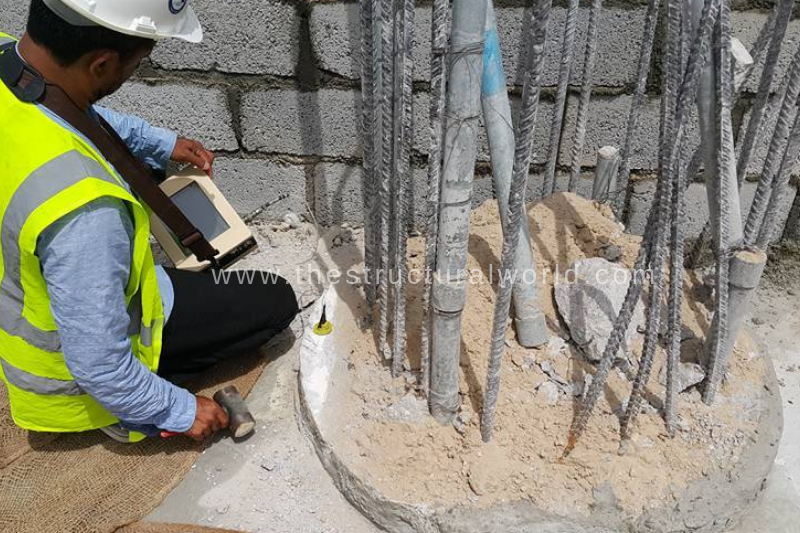
Most of the time, we don’t often pay attention to the piles after it is being cast. But, just like any other structural members, they are also prone to structural failures and sometimes noticing these damages is already too late when the settlement occurs. This failures and damages can be associated with the pile design or pile construction and workmanship. To avoid these unforeseen circumstances, it is required for piles to be tested at the early stage of construction. In this way, it is always economical to find a solution when we detect any pile damages at the start rather than detecting it on the latter part of the construction. There are so many pile tests available depending on its purpose, but the most common type of pile tests are the Dynamic Load Test, Static Load Test, and the Pile Integrity Test.
Dynamic Load Test
The ultimate strength of each pile must fulfill the structural and geotechnical limits for a safe foundation to perform as required. A pile load test is a direct method of determining the ultimate geotechnical capacity of the pile. Dynamic load testing with the aid of Pile Dynamic Analyzer (PDA) is a fast and reliable way to evaluate the bearing capacity of the pile. This testing can help you pick up the right pile type that can withstand the strains on the pile during driving and gives cautious if the pile driving reaches its required length thus avoiding unnecessary long piles. It also provides information about structural integrity, driving stresses, and hammer efficiency. If a dynamic load test is out of the equation, then a static load test can be performed.
Static Load Test
Like the dynamic load test, a Static Load test can be done to evaluate the bearing capacity of the pile. In the Static Load Test, the test load will be applied by hydraulic jacking against Kent ledge (concrete blocks) with the load being measured by calibrated and certified pressure gauges on the selected pile. The pile settlement will be recorded by means of dial gauges registering against a reference beam; optical level may be used to confirm the readings. The pile will be tested by increment loading according to the required standard with the record kept of time, load and settlement. Interpretation of the pile load test will be submitted to assess the pile capacity. The criteria for defining the load of the piles will be, but not limited to the following:
- The load at which settlement continues to increases without any further increase of load.
- The load beyond which there is an increase in net settlement disproportionate to the increase in load.
To test the load, a minimum load applied during the test will be equal to 1.5 times the working load. So it is important to identify the working load of the pile into consideration.
Scheme of Static Pile Load Test Set-up
Pile Integrity Test
The integrity test is an essential part of quality control in either cast-in-place or pre-cast concrete. This is because the possible structural defects from pile installation such as cracks, changes in cross-sections and the like can be detected by the use of this method. It is a Non-distracted Test (NDT) method that can evaluate the continuity and consistency of pile material, length, and cross-sectional area. The standard procedure of the pile integrity test has been in accordance with ASTM D5882.
Integrity test for cast-in-place concrete and pre-cast concrete with low strain method and ultrasonic method provides acceleration and velocity. The primary shockwave which travels down the length of the pile is reflected from the toe by the change in density between the concrete and the substrate. However, any discontinuities and defects encountered within its length will be reflected and added to the return signal. A hammer is used for impacting the pile head and should be applied vertically with the pile. Several impacts are applied on the top of the pile and the echoes are then being recorded for each individual impact by the use of motion or acceleration transducer. This apparatus will provide signal conditioning and integrate acceleration to obtain the velocity.
Since Integrity Test uses echoes or sounds to measure the pile discontinuities, accelerations, and velocities, it does not provide any information regarding the pile bearing capacity like the dynamic and static load test are capable of. It limits in evaluating the section of the piles that are below the cracks that cross into the entire pile cross section. It is always recommended that experienced professionals specialized in piling should handle this type of testing.
An Engineer conducting an Integrity Test on Pile
Tell us your thoughts! What are the other methods of pile testing aside from the mentioned above that you have encountered? Leave your comments below and feel free to share this article. You can also subscribe to our newsletter and follow us on our social media pages.
Please tell me how can I set the criteria for dropping the hammer for a dynamic load test?
ITS GOOD
GREAT JOB